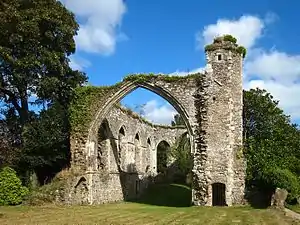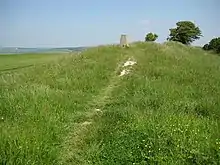Scheduled monuments in East Sussex
There are 931 scheduled monuments in the county of East Sussex, England.[1] These protected sites date from the Neolithic period and include barrows, moated sites, ruined abbeys, Iron Age hillforts, and a hill figure.[2] In the United Kingdom, the scheduling of monuments was first initiated to insure the preservation of "nationally important" archaeological sites or historic buildings. The protection given to scheduled monuments is given under the Ancient Monuments and Archaeological Areas Act 1979[3]
Notable scheduled monuments in East Sussex
| Image | Name | Location | Date | Notes |
|---|---|---|---|---|
 |
Battle Abbey | 50.91432°N 0.48683°E | 1094 | The ruined Benedictine abbey was built on the site of the Battle of Hastings.[4] |
 |
Bodiam Castle | 51.0023°N 0.5435°E | 14th century | Ruined quadrangular castle with the original moat, towers and portcullis.[5] |
 |
Greyfriars, Winchelsea | 50.9218°N 0.7103°E | 1242 AD | The monument consists of a ruined monastery of the Order of Friars Minor. It is considered the best example of Franciscan architecture in England.[6] |
 |
Hollingbury Castle | 50°51′19″N 0°7′23″W | 8th to 5th centuries BC | The site contains an Iron Age hillfort and three Bronze Age bowl barrows.[7] |
 |
Lewes Castle | 50°52′22″N 0°00′27″E | 1066 AD | The monument is a motte and bailey castle with the unusual feature of two mottes.[8] |
 |
Long Man of Wilmington | 50°48′36″N 0°11′17″E | Unknown | The monument is the largest representation of the human form in Europe.[9] |
 |
Pevensey Castle | 50.8188°N 0.3342°E | Fort: 3rd century AD, Castle 1066 AD | The monument includes a Roman Saxon Shore fort, an 11th-century enclosure castle, and the remains of later defenses.[10] |
|
|
Portslade Manor | 50.8432°N 0.2181°W | 12th century | One of a small number of remaining Norman manor houses in England. In 1807, the fortified manor was abandoned when a new manor house was built and it was later used as an almshouse for the poor.[11][12] |
_(3).JPG.webp) |
Whitehawk Camp | 50°49′39″N 0°6′43″W | 3700 BC to 3500 BC | An early Neolithic causewayed enclosure which originally consisted of a circular area surrounded by concentric rings of banks and ditches. These monuments were probably used for many functions, including defense, rituals and funerary purposes.[13] |
 |
Wilmington Priory | 50.8173°N 0.1903°E | 11th century | The Benedictine Priory was founded before 1243 on the site of an earlier settlement of the Grestain Abbey in Normandy, France.[14] |
References
- "Scheduled monuments: East Sussex". Historic England. Retrieved 19 February 2023.
- "Scheduled Ancient Monuments in the Historic County of Dorset". Ancient Monuments UK. Retrieved 28 January 2023.
- "Scheduled Monuments". Historic England. Retrieved 28 January 2023.
- "Battle Abbey". Historic England. Retrieved 24 February 2023.
- "A quadrangular castle and its landscaped setting, an associated millpond, medieval crofts and cultivation earthworks, and a World War II pillbox at Bodiam". Historic England. Retrieved 24 February 2023.
- "Grey Friars, Winchelsea". Historic England. Retrieved 24 February 2023.
- "Hillfort, the possible remains of a Romano-Celtic temple and a group of three bowl barrows at Hollingbury". Historic England. Retrieved 24 February 2023.
- "Lewes Castle". Historic England. Retrieved 2 March 2023.
- "The Long Man of Wilmington". Sussex Archaeological Society.
- "Pevensey Castle: a Saxon Shore fort, Norman defences, a medieval enclosure castle, and later associated remains". Historic England. Retrieved 5 March 2023.
- "Old manor house (remains of), Portslade-By-Sea". Historic England. Retrieved 6 March 2023.
- "The Manor House–Brighton's Oldest Home". Portslade History. Retrieved 6 March 2023.
- "Whitehawk Camp Causewayed Enclosure". Historic England. Retrieved 6 March 2023.
- "Wilmington Priory". Historic England. Retrieved 6 March 2023.
This article is issued from Wikipedia. The text is licensed under Creative Commons - Attribution - Sharealike. Additional terms may apply for the media files.
.jpg.webp)